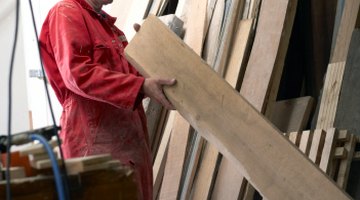Wood Beam Span Specifications
Table of Contents
Generally, builders install wood beams for structural support. The distance from one support to another represents the span. Engineers, architects and builders need to have knowledge of wood beam specifications to design economical and durable structures.

Span specifications are derived by taking into consideration the strength and stiffness of wood beams under transverse loads. This means the measurement of a beam's strength under a load when applying the load across the longitudinal flow of the grain. Key specifications include bending moment, deflection due to load, horizontal shear at the supports and bearing on the supports.
Bending Moment
Bending moment refers to the resistance of a wood beam to bending or sagging. The Modulus of Elasticity calculates the strength of wood and its ability to resist bending, stretching or curving under stress according to size, species, grade and other factors. Engineers derive MOE by using highly calibrated machines to stretch the wood. Simultaneously, the engineer adds increasing amounts of loads in the center of the wood. The researcher records the elongation or stretch of the wood and forecasts the deformity of the material under pressure. A high MOE shows a greater probability for deformation.
Horizontal Shear
Wood beams endure a vertical shearing force. Think of the roof structure, roof covering and other attachments as weighing down on the structure below. Wood beams also have longitudinal and horizontal shearing forces. This causes a beam to slide by the lower portion. To prevent this occurrence, the beam's shear resistance must equal or exceed the horizontal shear caused by the vertical force
Deflection
Deflection takes into account the amount of deformation that occurs as a wood beam resists bending under the structural load. As long as bending under the load has no affect on the design value, it does not impinge on the beam’s durability and strength. In addition, deflection considers the amount of vibration allowable for floors or the prevention of damage to fragile materials in residential construction. When the visual appearance or the rigidity of the structure has little significance, deflection does not matter. Make design decisions based on the beam’s strength. Deflection increases over time. If the structure requires a specific level of rigidity over the life of the structure, increase the size of the beam
Bearing on Supports
The load or weight placed on a wood beam compresses the beam's wood fibers at the sides that rest on supports - such as columns. To avoid this problem, the engineer must calculate the bearing areas of the columns and ensure they are large enough to transfer the weight. The formula for calculating the bearing areas takes into account the reaction of the beam, at the sides, when the weight is added. The formula also considers the grade and species of the wood. This calculation ensures the engineer selects the proper beam so that the weight does not crush the wood fibers and result in a collapse.
Grade and Species
The American Lumber Standard Committee Incorporated (ALSC), a non-profit organization, maintains American Lumber Standards, which considers the percentage of clear wood in lumber to determine its grade. The grades for wood beams depend on the minimum percentage of clear wood and are as follow: Select - 80 percent clear wood; #1 Structural - 75 percent; #2 Structural - 66 percent; #3 Structural -50 percent; Construction Grade - 57 percent; Standard Grade - 43 percent; and Utility Grade - 29 percent.
The lumber mill must stamp the species on the lumber, such as D FIR (Douglas Fir), S-P-F ( Spruce-Pine-Fir) or Hem Fir (Hemlock-Fir).
References
- AWC:Wood Structural Design Data
- American Lumber Standard Committee Incorporated :General Information
- Handbook of Construction Contracting: Plans, Specs, Building, Jack Payne Jones, 1986
Writer Bio
John Landers has a bachelor's degree in business administration. He worked several years as a senior manager in the housing industry before pursuing his passion to become a writer. He has researched and written articles on a wide variety of interesting subjects for an array of clients. He loves penning pieces on subjects related to business, health, law and technology.
Photo Credits
- Michael Blann/Digital Vision/Getty Images
- Michael Blann/Digital Vision/Getty Images
More Articles



